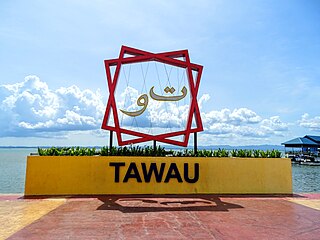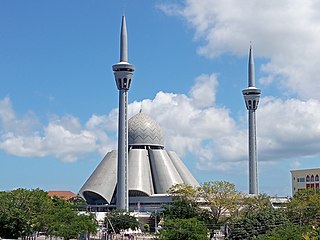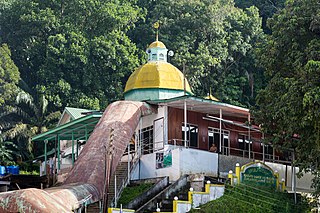
Tawau formerly known as Tawao, is the capital of the Tawau District in Sabah, Malaysia. It is the third-largest city in Sabah, after Kota Kinabalu and Sandakan. It is located on the Semporna Peninsula in the southeast coast of the state in the administrative centre of Tawau Division, which is bordered by the Sulu Sea to the east, the Celebes Sea to the south at Cowie Bay and shares a border with North Kalimantan, Indonesia. The town had an estimated population as of 2010, of 113,809, while the whole municipality area had a population of 397,673.

The National Mosque of Malaysia is a mosque in Kuala Lumpur, Malaysia. It has a capacity for 15,000 people and is situated among 13 acres (53,000 m2) of gardens. Its key features are a 73-metre-high (240 ft) minaret and a 16-pointed star concrete main roof. The umbrella, synonymous with the tropics, is featured conspicuously – the main roof is reminiscent of an open umbrella, the minaret's cap a folded one. The folded plates of the concrete main roof are a creative solution to achieving the larger spans required in the main gathering hall. Reflecting pools and fountains spread throughout the compound. Completed in 1965, the mosque is a bold and modern approach in reinforced concrete, symbolic of the aspirations of a then newly independent nation.

Al-Azim Mosque is the state mosque of Malacca. It is located next to the Malacca General Hospital, the Malacca Al-Quran Museum and the State Heroes Mausoleum and was constructed to replace the former state mosque at Tranquerah Mosque and officially opened on 13 July 1990 by the ninth Yang di-Pertuan Agong, Sultan Azlan Shah of Perak.

The Federal Territory Mosque is a mosque in Kuala Lumpur, Malaysia. It is located near MATRADE complex and the Federal Government Complex off Jalan Duta, in Segambut district.

This article lists important figures and events in Malaysian public affairs during the year 1995, together with births and deaths of notable Malaysians.

Malacca Straits Mosque is a mosque located on the man-made Malacca Island in Malacca City, Malacca, Malaysia, which was opened on 24 November 2006 by the Supreme Ruler of Malaysia Tuanku Syed Sirajuddin Syed Putra Jamalullail and was constructed with a cost of about MYR10 million. It was built using the mix of Middle Eastern and Malay craftsmanship and looks like a floating structure when the water level is high. Its structure has two intersecting archways lead to the main entrance and stained glass which covers the space in between the arches. The mosque compound has a 30-metre tall minaret that is also used as a lighthouse.

The Kota Kinabalu City Mosque is the second main mosque in Kota Kinabalu, Sabah, Malaysia, after State Mosque in Sembulan. The head imam is Ustaz Haji Hafiz Bin Datuk Dr Haji Hamzah.
The Filipino Malaysians consists of people of full or partial Filipino descent who were born in or immigrated to Malaysia. Filipinos in Malaysia comprise migrants and residents from the Philippines and their descendants living in Malaysia. Because of the short distance between the two nations, many Filipinos mainly from Mindanao have migrated to the Malaysian state of Sabah to escape from the conflict, poverty and in search for better lives. About 325,089 Filipinos live in Malaysia. Many of them are illegal residents while there are a smaller number of migrant workers and fewer permanent residents.
Tun Datuk Seri Utama Syed Ahmad bin Syed Mahmud Shahabuddin was a Malaysian politician. He was the Menteri Besar of Kedah from 1967 to 1978 and the fifth Yang di-Pertua Negeri (Governor) of Melaka state from 1984 until 2004, the longest-serving governor of Malacca.

The An-Nur Jamek Mosque or Masjid Jamek An-Nur is a mosque in the Federal Territory of Labuan, Malaysia.
Dato' Y. T. Lee, also Lee Yoon Thim was a Malaysian Chinese architect active in Kuala Lumpur in the 1950s and 1960s. He helped "Build Merdeka" after Malaysian Independence, 1963. He moved in elite circles, and held several positions in the national government and in the Chinese community. He was a close friend to Prime Minister Tuanku Abdul Rahman and other political figures. He designed several of Kuala Lumpur's landmark buildings, such as: Chin Woo Stadium, UMNO building, Dewan Bahasa dan Pustaka, Federal Hotel, Kampung Baru Mosque, Ar-Rahman Mosque and the Masjid Al-Ubudiyah. In addition to his famous mosques in Kuala Lumpur, he also worked on middle eastern and Islamic architecture project, for example, Masjid Al- Ubudiyah in Kerling, Hulu Selangor which is opened in 1960. When this masjid is built, there was no electricity supply yet. Somehow now it has been used as a teaching place by the locals. His less well known works include the Too House, an addition for the Methodist Boys School, and healthcare-related and commercial work. In the early 1960s, a series of honours came his way: in 1960, he was granted the appellation of P.J.K.; in 1961, he was honoured as Justice of Peace and J.M.N in 1962; he was honoured as Dato' in 1964, an honorific similar to the British "Sir".

repa

The Alwi Mosque is a mosque in Kangar, Perlis, Malaysia.
The Al-Rahman Mosque is a mosque in Kuala Lumpur, Malaysia. The mosque is located at University of Malaya in Jalan Pantai Baharu and was named after the first Malaysian Prime Minister, Tunku Abdul Rahman Putra Al-Haj. Today, the mosque is joint managed by University of Malaya and the Department of Federal Territory Islamic Affairs (JAWI).

The Sandakan District Mosque is a mosque in Sandakan, Sabah, Malaysia. Built in 1985 and completed in 1989, it is the main mosque for the district of Sandakan. The mosque was officially opened in 1990.

The Sandakan Jamek Mosque is a mosque in Sandakan, Sabah, Malaysia. Opened in 1890, it is the oldest mosque in Sandakan, part of Sandakan Heritage Trail.

Jamek Mosque, officially Sultan Abdul Samad Jamek Mosque is one of the oldest mosques in Kuala Lumpur, Malaysia. It is located at the confluence of the Klang and Gombak River and may be accessed via Jalan Tun Perak. The mosque was designed by Arthur Benison Hubback, and built in 1909.

The Tawau District is an administrative district in the Malaysian state of Sabah, part of the Tawau Division which also includes the districts of Kunak, Lahad Datu, Semporna and Tawau. The capital of the district is in Tawau Town.



















